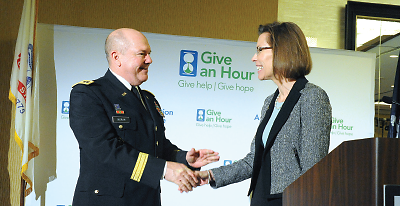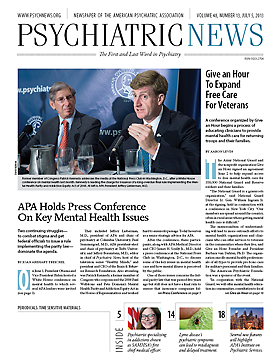The Army National Guard and the nonprofit organization Give an Hour signed an agreement June 2 to help expand access to free mental health care for 350,000 National Guard and Reserve soldiers and their families.
“The National Guard is a grassroots organization,” said National Guard Director Lt. Gen. William Ingram Jr. at the signing, held in conjunction with a conference in New York City. “Our members are spread around the country, often in rural areas where getting mental health care is difficult.”
The memorandum of understanding will lead to more outreach efforts to mental health organizations and clinicians who can offer services to veterans in the communities where they live, said Give an Hour Founder and President Barbara van Dahlen, Ph.D. The organization enrolls mental health professionals of all types to provide pro bono care for military personnel and their families.
The American Psychiatric Foundation was a sponsor of the event.
“In cooperation with the National Guard, we will offer mental health education in communities, consultation to local organizations, and help with referrals,” van Dahlen told Psychiatric News. “Not all veterans have pathology, but all are affected in some way by war, and with our help can make a good transition home.”
The conference, designed to inform current and future mental health practitioners about the challenges facing troops returning from war and ways to help them, was held at New York-Presbyterian/Columbia University Medical Center.
Obstacles Need to Be Confronted
Clinicians will have to overcome several obstacles to providing care for the program’s target population, Annelle Primm, M.D., M.P.H., told attendees.
“Stigma is not limited to military or veterans communities, but in a culture of stoicism and strength, it is hard to come forward and admit needing help,” said Primm, APA’s deputy medical director and director of its Office of Minority and National Affairs. “Psychiatrists and other mental health professionals must always be knowledgeable about the cultures from which people come. So we must ask patients about their military or veteran status to help develop a person-centered approach to care.”
An understanding of the underlying neuroscience of mental illness and brain disorders also is needed to manage diagnosis and care, said Bruce McEwen, Ph.D., a professor at Rockefeller University in New York.
“Repeated stress experiences affect the adult brain in different ways,” said McEwen. “Neurons in the hippocampus shrink and become less efficient in communicating information, while neurons in parts of the amygdala involved in anxiety and fear grow and become more functionally connected as part of the same stress.”
With treatment, however, these brain changes are reversible in many patients, said McEwen. The amygdala of a person with chronic anxiety who responds to a mindfulness-based stress-reduction program can grow smaller with successful treatment, showing that behavior can change the brain.
TBI Assessment Is Crucial
Traumatic brain injuries (TBI), all too frequent in the conflicts in Iraq and Afghanistan, are both a matter for concern in themselves and a potential obstacle to care, said John Corrigan, Ph.D., a professor and director of the Division of Rehabilitation Psychology in the Department of Physical Medicine and Rehabilitation at Ohio State University Medical Center in Columbus.
“There are high levels of TBI in both civilian and military populations so we always have to ask if the patient has had a TBI, the extent of the injury, when was the age of the first TBI, what was the worst one, and if they have experienced more than one,” he said.
The cognitive load of therapy itself was yet another consideration. Patients entering therapy have to learn a new vocabulary—the vocabulary of treatment—and since attention, learning, and memory problems are typical following a TBI, they may need special accommodation, said Corrigan. Being late for an appointment may be a symptom, not a “lack of motivation,” so therapists may have to introduce more structure into treatment planning and sessions.
“Understanding cognitive load has to become part of all behavioral health care from here on out,” said Corrigan. “When it does, we will all better serve our service members.”
Psychiatrist and retired Army Col. Charles Hoge, M.D., a researcher at the Walter Reed Army Institute of Research, pointed out the irony of posttraumatic stress disorder (PTSD).
“Each symptom of PTSD has adaptive value,” he said. “Hypervigilance is highly useful in combat, and emotional numbing reduces distraction on the battlefield. But they all have negative effects when the soldier comes home.”
Another—and sadder—irony is that while PTSD treatment has a 70 percent to 80 percent success rate if completed, half of the military members who could be diagnosed with the disorder do not enter treatment at all, and half of those who begin treatment drop out, he said.
Life circumstances, job changes, stigma, a belief in self-reliance, and negative prior encounters with the health care or mental health systems lead to those drop-outs.
“Reluctance to speak is a constant, yet narration is the most important part of the healing process,” said Hoge. “People need more than just manualized therapeutic templates, and dialogue in the supervision process can help practitioners.” ■


